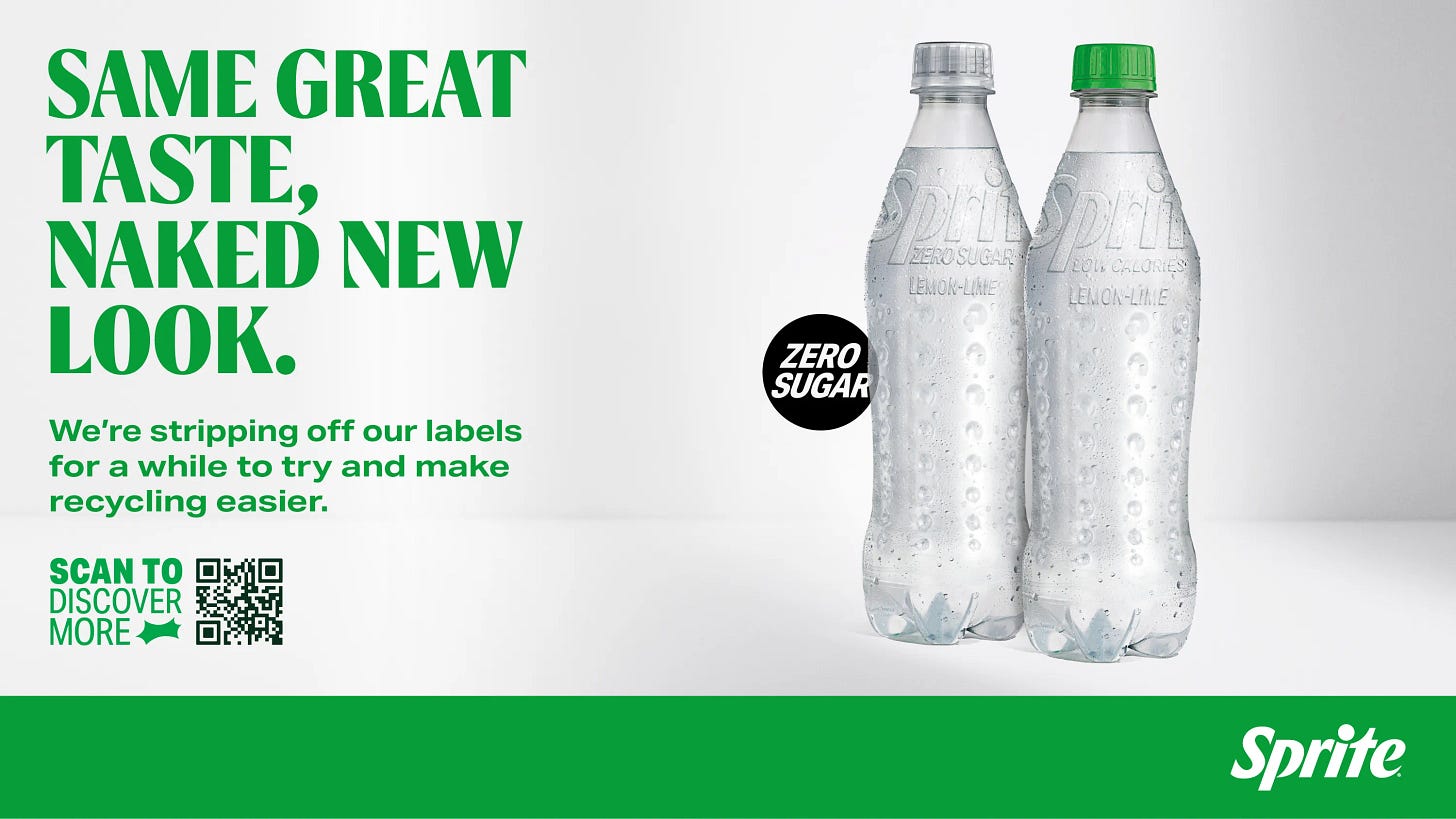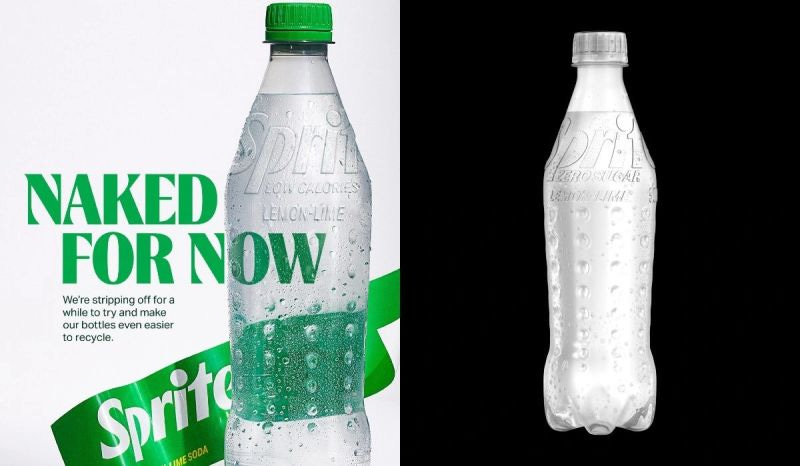New "Easier to Recycle" Bottles from Sprite
Naked is the new trend to make bottles easier for recycling
In order to make bottles easier for recycling, labels on Sprite and Sprite Zero products will be taken away. 👏
This initiative raises intriguing questions about the future of plastic packaging and its environmental impact.
Here's a deeper dive into the potential of this approach, considering the complexities of plastic waste and the challenges it presents.
The Multi-Material Mayhem:
The current design of plastic beverage bottles like Sprite's is a recipe for recycling headaches.
Here's the breakdown:
PET (Polyethylene Terephthalate): The clear, rigid plastic making up the main body of the bottle. It's generally considered the most recyclable type of plastic, with a global recycling rate of around 14%.
PVC (Polyvinyl Chloride): The labels, often made from PVC, pose a sorting challenge. PVC has a different melting point than PET, making it difficult to separate during recycling and potentially contaminating the PET stream.
PP (Polypropylene): The caps, typically made from PP, can become separated from the bottle during collection and transportation, ending up in landfill or even the ocean.
These three different types of plastic on a single bottle create inefficiencies in the recycling process.
A whopping 2.2 million tons of plastic bottles end up in landfills globally every year.
The Label-Less Solution (or is it?):
Coca-Cola's trial tackles this challenge head-on by eliminating the PVC labels:
Goodbye Labels: The most obvious change is the removal of the plastic labels, potentially reducing sorting complexities and contamination risks.
Hello Embossed Logos: Product information will be directly embossed onto the clear PET bottle itself, creating a sleeker design. The durability of this embossing is crucial – it needs to withstand transportation and handling without fading or becoming illegible.
Attached Caps: The existing PP caps will remain tethered to the bottle, ensuring they don't get separated during recycling.
Potential Benefits, Measurable Impact?
Simplified Sorting: Removing labels, especially those made from different plastics, can potentially reduce sorting complexities at recycling facilities by up to 10%. This translates to a cleaner recycling stream and potentially higher recycling rates – a significant factor considering the 11 million metric tons of plastic waste that leak into the ocean every year.
Reduced Waste: Eliminating labels translates to less overall plastic used per bottle. While seemingly small, this can add up significantly across millions of bottles produced. Estimates suggest this could lead to a reduction of 5% or more in plastic used per bottle.
Consumer Awareness: The label-less design acts as a visual reminder of the importance of proper recycling. However, clear communication strategies and potentially color-coded caps might be necessary to address any confusion about product identification or recycling instructions.
Challenges and Considerations: Beyond the Label
While this trial holds promise, there are limitations to consider:
Limited Scope: Currently, this is a small trial in eight Tesco Express stores in the UK. The effectiveness and scalability of this approach require further testing across a wider geographical area and with different recycling infrastructure.
Consumer Confusion: Without labels, consumers might struggle to identify the product, especially those with visual impairments, or understand recycling instructions. Clear communication and potentially color-coded caps could be solutions.
Durability of Embossing: The embossed logos need to be durable enough to withstand transportation and handling without fading or becoming illegible.
Overall Plastic Use: While labels are removed, the core PET plastic bottle remains. Addressing the overall plastic consumption and exploring alternative materials is crucial in the long run.
Industry Context:
Growing Environmental Concerns: Plastic pollution is a major environmental threat, with plastic waste harming marine life, ecosystems, and potentially even human health. Initiatives like Coca-Cola's trial demonstrate efforts within the industry to address these issues. The Ellen MacArthur Foundation estimates that by 2050, there could be more plastic than fish in the ocean by weight if current trends continue.
Demand for Sustainable Packaging: Consumers are increasingly demanding more sustainable packaging solutions. A 2021 NielsenIQ survey revealed that 83% of global consumers are willing to pay more for sustainable packaging. This trial could cater to that growing demand.
Regulations and Legislation: Governments around the world are implementing stricter regulations on plastic use and waste management. The European Union, for example, has banned single-use plastic straws, cutlery, and cotton buds. This could push for more innovations in packaging design and materials.
The Verdict? A Measured Step Forward
This label-less bottle trial is a positive step towards simplifying the recycling process for certain plastic packaging. However, it's just one sip of a much larger solution. For a more sustainable future, the industry needs to focus on several key areas:
Material Innovation: Exploring alternative, biodegradable, or easily recyclable materials for bottles and packaging. Biodegradable options like polylactic acid (PLA) derived from corn starch are promising but require further development to ensure scalability and cost-effectiveness.
Improved Recycling Infrastructure: Investing in more efficient sorting and processing technologies for handling mixed-material plastics. Technologies like near-infrared (NIR) sorting can help identify different plastic types more accurately, leading to cleaner recycling streams.
Consumer Education: Raising awareness about proper waste management and responsible consumption habits. Educational campaigns can encourage consumers to choose products with minimal packaging, recycle correctly, and hold companies accountable for sustainable practices.
Coca-Cola's initiative might be a small step, but it's a step in the right direction. By combining such innovations with broader industry efforts, responsible consumer behavior, and robust government regulations, we can move towards a more circular economy where plastic waste is minimized and resources are effectively recycled. This will require not just removing labels, but a complete rethinking of how we design, use, and dispose of plastic packaging.




